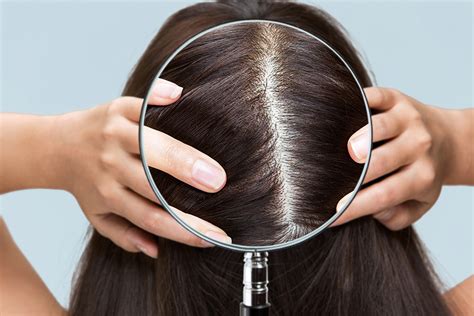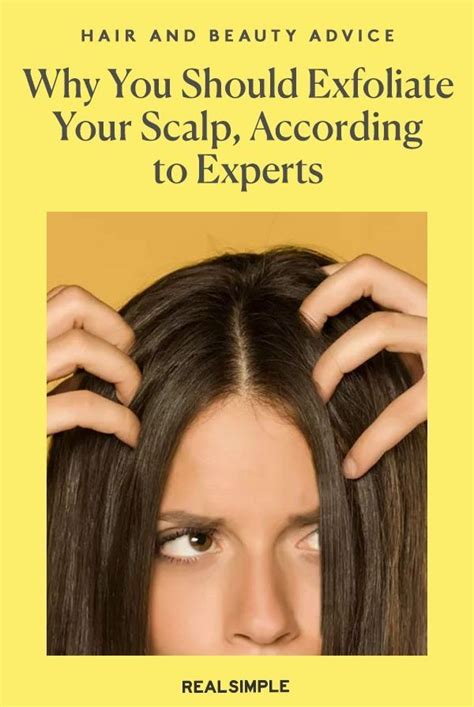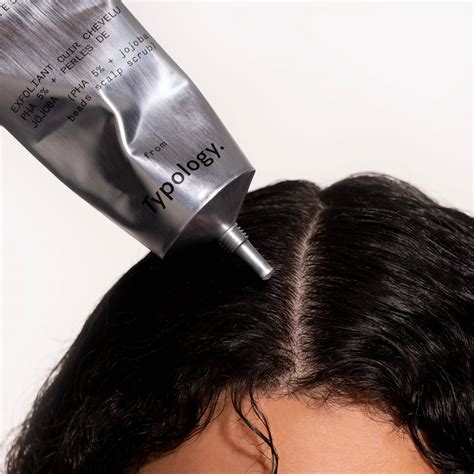Are you yearning for a revitalizing experience that will give your scalp the pampering it deserves? Look no further! In this informative article, we delve into the realm of scalp peeling and unveil a plethora of extraordinary benefits and techniques that will leave you astounded.
Gone are the days when scalp peeling was merely seen as a luxury reserved for the elite. Today, this exceptional treatment has become increasingly popular among individuals seeking relief from various scalp issues and desiring a refreshed and healthier scalp. By gently exfoliating the scalp, scalp peeling effectively removes impurities, dead skin cells, and excess oils, thus unclogging the hair follicles and promoting improved hair growth.
Indulging in a revitalizing scalp peeling session not only enhances the overall health of your scalp but also revitalizes your senses. The unique techniques employed during this extraordinary treatment stimulate blood circulation, promoting the delivery of essential nutrients to the hair follicles. Additionally, these invigorating techniques, accompanied by the application of carefully selected products, leave your scalp feeling invigorated, rejuvenated, and incredibly refreshed.
The Significance of Scalp Health for Hair Growth

A healthy scalp plays a crucial role in promoting optimal hair growth and maintaining the overall vitality of your hair. Caring for your scalp not only ensures a nourishing environment for your hair follicles but also helps to prevent common hair problems such as dandruff, hair loss, and dryness. By understanding the importance of scalp health, you can take proactive measures to keep your hair looking and feeling its best.
| Benefits of Scalp Health | |||
|---|---|---|---|
| Enhanced circulation | Regulated sebum production | Strengthened hair follicles | Reduced hair breakage |
| Improved hair texture | Inhibited dandruff formation | Promoted hair growth | Increased hair shine |
Proper scalp care involves maintaining a balance of moisture, oil production, and pH levels. This can be achieved through regular cleansing, exfoliation, and moisturization. When the scalp is clean, free from excess oils, and properly hydrated, it provides an environment where hair follicles can thrive, resulting in healthier and stronger hair growth.
In addition to regular cleansing, employing gentle massage techniques during scalp care can be highly beneficial. Massaging the scalp helps to stimulate blood flow, which in turn nourishes the hair follicles and promotes hair growth. Moreover, it can help to relax the scalp muscles and reduce tension, contributing to a healthier and more rejuvenated scalp.
By prioritizing the health of your scalp, you can effectively address common hair problems and pave the way for lush, vibrant hair growth. In conjunction with a balanced diet, proper hydration, and a consistent hair care routine, maintaining a healthy scalp is a key aspect of achieving and maintaining your desired hair goals.
Understanding Scalp Exfoliation and How It Functions
Have you ever wondered about the process of revitalizing your scalp and removing dead skin cells? Scalp exfoliation, also known as scalp peeling, is a technique that can provide various benefits to your hair and scalp health. By gently removing built-up dirt, excess oils, and dead skin cells, scalp peeling promotes improved circulation, enhances hair growth, and maintains a balanced pH level.
Scalp peeling works by incorporating gentle exfoliating agents that help to eradicate impurities from the scalp's surface. These exfoliating agents can come in the form of physical scrubs, enzymatic peels, or chemical exfoliators. Depending on the product or technique you choose, the ingredients may vary, but ultimately, the goal remains the same – to cleanse the scalp effectively.
Physical scrubs typically contain small granules or beads that physically buff away the dead skin cells and impurities when massaged into the scalp. Enzymatic peels, on the other hand, contain natural fruit enzymes like papain or bromelain, which break down the bonds between dead skin cells, resulting in easy removal. Chemical exfoliators usually contain alpha or beta hydroxy acids, such as salicylic acid, that effectively dissolve surface debris.
Regardless of the method chosen, regular scalp peeling can help maintain a healthy scalp environment for optimal hair growth. It removes accumulated dirt, unclogs hair follicles, and encourages cellular turnover, allowing for the growth of new, healthy hair. Moreover, scalp peeling aids in the prevention of scalp conditions like dandruff and seborrheic dermatitis, with its exfoliating properties helping to control flakiness and itchiness.
In conclusion, scalp peeling is an essential step in hair and scalp care, offering multiple benefits by eliminating dirt and dead skin cells. Whether you opt for physical scrubs, enzymatic peels, or chemical exfoliators, incorporating scalp peeling into your hair care routine can promote a refreshed, healthier scalp and ultimately result in lustrous, vibrant hair.
The Advantages of Exfoliating the Scalp for Healthy Hair and Scalp

Enhancing the condition of your scalp is key to achieving lustrous and vibrant hair. One effective method to promote a healthy scalp environment is scalp peeling. This technique offers numerous benefits by exfoliating the scalp, removing impurities, and stimulating blood circulation.
Exfoliating the scalp aids in unclogging hair follicles, allowing for better absorption of hair care products and nutrients. By eliminating dead skin cells, excess oil, and product build-up, scalp peeling promotes a balanced scalp pH level, reducing the risk of scalp issues such as dandruff, itchiness, and oiliness.
Moreover, scalp peeling stimulates blood flow to the hair follicles, which encourages hair growth and strengthens the hair shaft. It can also help to alleviate dryness and flakiness, promoting a healthier scalp appearance and preventing hair breakage.
Additionally, scalp peeling improves the effectiveness of hair care products. With a clean and exfoliated scalp, the products can penetrate deeply into the follicles, ensuring optimal nourishment and moisturization. This can lead to enhanced hair texture, shine, and overall hair health.
It is important to note that there are various techniques available for scalp peeling, ranging from mechanical exfoliation methods such as scalp brushes or scrubs to chemical exfoliation using specially formulated scalp peels. Depending on individual preferences and scalp conditions, one can choose the most suitable technique to enjoy the benefits of scalp peeling.
In conclusion, regular scalp peeling is a valuable practice for promoting hair and scalp health. By exfoliating the scalp, it helps to remove impurities, improve blood circulation, and enhance the effectiveness of hair care products, resulting in a healthier scalp environment and beautiful, nourished hair.
Choosing the Right Technique to Revitalize Your Scalp
When it comes to revitalizing your scalp, selecting the appropriate technique is essential. Each individual has unique scalp needs, preferences, and goals in mind. Understanding the different techniques available will help you make an informed choice for achieving a healthy and rejuvenated scalp.
- Manual Scrub: This technique involves using gentle circular motions with your fingertips or a soft brush to exfoliate the scalp. It is ideal for those who prefer a hands-on approach and want to control the amount of pressure applied.
- Chemical Exfoliation: This technique utilizes specially formulated scalp exfoliating products that contain acids, enzymes, or active ingredients. These products help to remove dead skin cells, excess oil, and build-up from the scalp, leaving it refreshed and revitalized.
- Microdermabrasion: Similar to facial treatments, microdermabrasion is a mechanical exfoliation technique that uses a wand with a textured surface to gently remove dead skin cells from the scalp. It is a popular choice for those seeking a more intensive scalp exfoliation.
- Laser Therapy: This technique utilizes focused laser beams to stimulate blood circulation and promote the removal of dead skin cells and debris from the scalp. It is a non-invasive option that can help improve scalp health and hair growth.
Choosing the right scalp peeling technique depends on your scalp condition, personal preferences, and desired outcomes. It is recommended to consult with a professional or dermatologist who can assess your scalp's needs and guide you in selecting the most suitable technique for you.
Step-by-Step Guide to Performing a Soothing Scalp Exfoliation at Home

Are you yearning for a rejuvenating experience that brings comfort and renewed energy to your scalp? Look no further than a DIY scalp exfoliation! In this comprehensive guide, we will walk you through the step-by-step process of performing a soothing scalp peeling treatment in the comfort of your own home.
Before diving into the technique, it is important to understand the benefits of scalp exfoliation. By removing buildup of dead skin cells, excess oil, and product residues, this relaxing treatment can help improve circulation, promote hair growth, and enhance the overall health of your scalp. Additionally, it can create a clean canvas for your hair products to work more effectively.
1. Begin by wetting your hair and scalp thoroughly. This will help soften the skin and prepare it for exfoliation. Use lukewarm water to avoid stripping away natural oils.
2. Apply a gentle exfoliating scrub or mask to your scalp. Massage it into your scalp using circular motions with your fingertips. Be sure to cover the entire scalp, paying special attention to areas prone to flakiness or dryness.
3. After massaging for a few minutes, leave the scrub or mask on your scalp for the recommended duration. This will allow the active ingredients to work their magic and deeply cleanse the skin.
4. Rinse off the scrub or mask thoroughly, ensuring no residue remains on your scalp. Use lukewarm water again to avoid any discomfort.
5. Next, gently pat your scalp dry with a soft towel. Avoid vigorous rubbing, as this can cause further irritation to the skin.
6. Finish off the scalp exfoliation by applying a lightweight, nourishing scalp serum or oil. Massage it into your scalp using gentle pressure to promote relaxation and enhance the absorption of the product.
7. Allow the serum or oil to penetrate your scalp for a few minutes before styling your hair as desired. Your scalp will feel refreshed, invigorated, and ready to take on the day!
Performing a scalp peeling at home is not only a luxurious self-care ritual, but it can also provide numerous benefits for your scalp health. By following this step-by-step guide, you can easily incorporate this soothing treatment into your regular hair care routine and enjoy a refreshing and revitalizing scalp experience.
Exploring Professional Options for a Rejuvenating Treatment for Your Scalp
When it comes to revitalizing your scalp and promoting overall hair health, professional scalp peeling options and salon treatments offer a range of benefits and techniques that can help you achieve your desired results. These treatments go beyond traditional methods and delve into specialized approaches that cater to specific scalp concerns and conditions.
One popular professional scalp peeling option is the enzymatic scalp treatment. This technique involves the use of gentle yet effective enzymes that break down debris and impurities on the scalp, promoting a cleaner and healthier environment for hair growth. Enzymatic treatments are particularly beneficial for individuals with oily scalps and can help control excess sebum production.
For individuals experiencing dry and flaky scalps, salon treatments often include chemical exfoliation methods such as microdermabrasion. This procedure uses fine crystals or a diamond-tipped wand to remove dead skin cells, unclog pores, and stimulate blood circulation in the scalp. By removing the buildup of dead skin and promoting cell turnover, microdermabrasion can alleviate itching and flaking while improving overall scalp health.
Another popular option available in salons is the use of scalp peeling masks. These masks are formulated with a blend of exfoliating ingredients that gently remove buildup and impurities from the scalp, while nourishing and hydrating the skin. Scalp peeling masks often contain ingredients like salicylic acid, alpha hydroxy acids (AHAs), or natural enzymes like papaya or pineapple extracts, all of which aid in exfoliation and promote a balanced and revitalized scalp.
In addition to these techniques, some salons offer scalp peeling treatments using devices such as scalp brushes or electric exfoliators. These devices work to mechanically exfoliate the scalp, removing debris and stimulating circulation. The precise technique used may vary depending on the salon and the specific needs of your scalp.
Regardless of the professional scalp peeling option or salon treatment you choose, it is essential to consult a trained professional who can assess your specific scalp condition and recommend the most suitable approach. Regular scalp peeling treatments can promote a healthier scalp environment, prevent hair problems, and enhance the effectiveness of other hair care products, ultimately leading to luscious and rejuvenated hair.
Precautions and Possible Side Effects of Scalp Exfoliation

When considering a scalp exfoliation treatment, it is important to be aware of the precautions and potential side effects that may arise. Although scalp exfoliation can provide numerous benefits for the overall health and appearance of the scalp, it is crucial to proceed with caution and follow proper guidelines to ensure a safe and effective treatment.
Precautions:
Before undergoing scalp exfoliation, it is recommended to consult with a professional dermatologist or trichologist to assess the condition of your scalp and determine if you are a suitable candidate for the procedure. They can provide personalized guidance based on your specific needs and any underlying scalp conditions you may have.
Additionally, it is important to avoid scalp exfoliation if you have any open wounds, cuts, infections, or active dermatological conditions on your scalp. Exfoliating these areas may worsen the condition and cause further irritation and discomfort.
Possible Side Effects:
While scalp exfoliation can offer various benefits, there are potential side effects that individuals should be aware of. These side effects may vary depending on the individual's skin sensitivity and the techniques used during the treatment.
One possible side effect is scalp sensitivity or irritation, which may occur if the exfoliation process is too harsh or if unsuitable products are used. It is essential to follow the recommended techniques and use gentle, non-abrasive exfoliants to minimize the risk of irritation.
Another potential side effect is temporary redness or discomfort after the treatment. This reaction is typically mild and should subside within a few hours. However, if the redness persists or intensifies, it is advisable to seek professional advice.
Individuals with certain scalp conditions, such as psoriasis or eczema, should exercise caution when considering scalp exfoliation. The exfoliation process can exacerbate these conditions and lead to increased inflammation or flare-ups. Seeking guidance from a healthcare professional is crucial in such cases.
It is also important to note that over-exfoliating the scalp can disrupt the natural balance of oils, leading to dryness or excess oil production. Maintaining a suitable exfoliation frequency and using hydrating products afterward can help mitigate these effects.
In conclusion, while scalp exfoliation can offer numerous benefits for the scalp, it is vital to take precautions and be aware of possible side effects. By consulting with professionals, following recommended techniques, and paying attention to your individual skin response, you can enjoy the advantages of scalp exfoliation while minimizing any potential risks.
FAQ
What is a scalp peeling?
A scalp peeling is a cosmetic procedure designed to exfoliate the scalp, removing dead skin cells, excess oil, and product buildup. It helps rejuvenate the scalp, promote healthier hair growth, and improve overall scalp health.
What are the benefits of a scalp peeling?
There are several benefits of a scalp peeling. Firstly, it helps unclog hair follicles, allowing for better absorption of hair care products. Secondly, it promotes blood circulation in the scalp, which can enhance hair growth. Additionally, it can relieve dryness, itchiness, and dandruff, resulting in a refreshed and healthier scalp.
What techniques are used for a scalp peeling?
There are various techniques used for a scalp peeling. One common method involves using a scalp scrub or exfoliating shampoo to massage the scalp and remove impurities. Another technique involves using natural ingredients such as sea salt or sugar mixed with oils to create a gentle scrub. Additionally, some salons offer professional scalp peeling treatments using specialized tools and equipment for a more thorough exfoliation.



